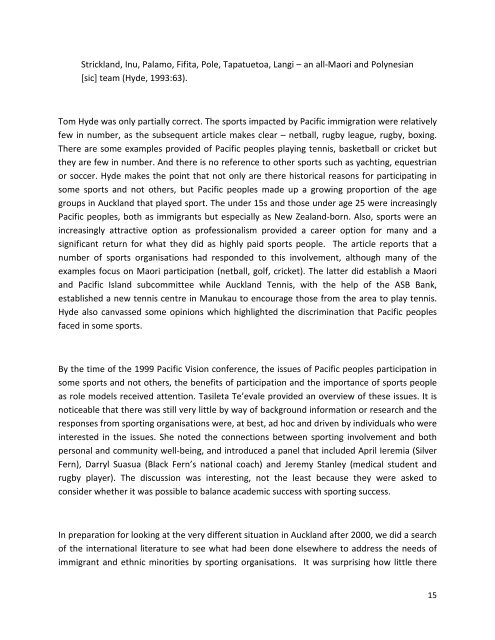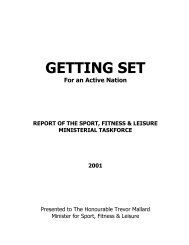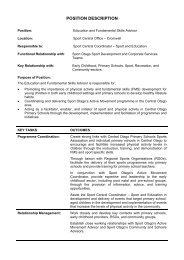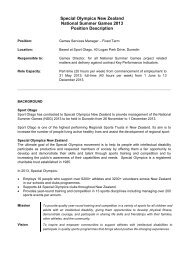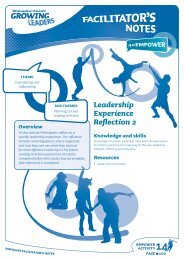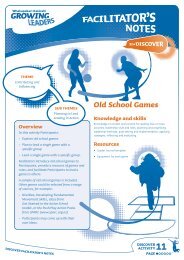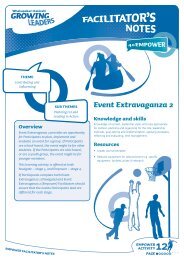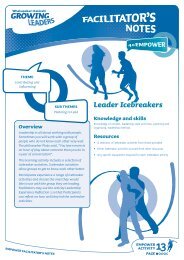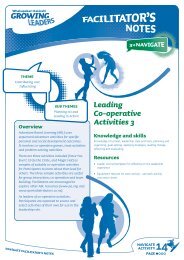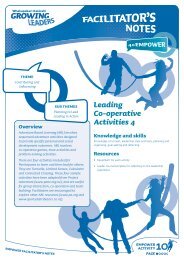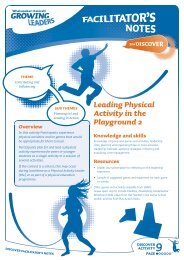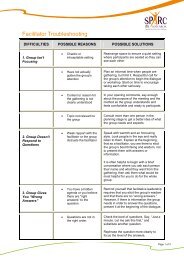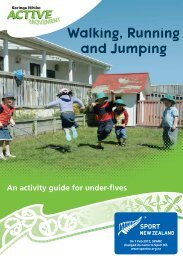sport and cultural diversity - Sport New Zealand
sport and cultural diversity - Sport New Zealand
sport and cultural diversity - Sport New Zealand
Create successful ePaper yourself
Turn your PDF publications into a flip-book with our unique Google optimized e-Paper software.
Strickl<strong>and</strong>, Inu, Palamo, Fifita, Pole, Tapatuetoa, Langi – an all-Maori <strong>and</strong> Polynesian<br />
[sic] team (Hyde, 1993:63).<br />
Tom Hyde was only partially correct. The <strong>sport</strong>s impacted by Pacific immigration were relatively<br />
few in number, as the subsequent article makes clear – netball, rugby league, rugby, boxing.<br />
There are some examples provided of Pacific peoples playing tennis, basketball or cricket but<br />
they are few in number. And there is no reference to other <strong>sport</strong>s such as yachting, equestrian<br />
or soccer. Hyde makes the point that not only are there historical reasons for participating in<br />
some <strong>sport</strong>s <strong>and</strong> not others, but Pacific peoples made up a growing proportion of the age<br />
groups in Auckl<strong>and</strong> that played <strong>sport</strong>. The under 15s <strong>and</strong> those under age 25 were increasingly<br />
Pacific peoples, both as immigrants but especially as <strong>New</strong> Zeal<strong>and</strong>-born. Also, <strong>sport</strong>s were an<br />
increasingly attractive option as professionalism provided a career option for many <strong>and</strong> a<br />
significant return for what they did as highly paid <strong>sport</strong>s people. The article reports that a<br />
number of <strong>sport</strong>s organisations had responded to this involvement, although many of the<br />
examples focus on Maori participation (netball, golf, cricket). The latter did establish a Maori<br />
<strong>and</strong> Pacific Isl<strong>and</strong> subcommittee while Auckl<strong>and</strong> Tennis, with the help of the ASB Bank,<br />
established a new tennis centre in Manukau to encourage those from the area to play tennis.<br />
Hyde also canvassed some opinions which highlighted the discrimination that Pacific peoples<br />
faced in some <strong>sport</strong>s.<br />
By the time of the 1999 Pacific Vision conference, the issues of Pacific peoples participation in<br />
some <strong>sport</strong>s <strong>and</strong> not others, the benefits of participation <strong>and</strong> the importance of <strong>sport</strong>s people<br />
as role models received attention. Tasileta Te’evale provided an overview of these issues. It is<br />
noticeable that there was still very little by way of background information or research <strong>and</strong> the<br />
responses from <strong>sport</strong>ing organisations were, at best, ad hoc <strong>and</strong> driven by individuals who were<br />
interested in the issues. She noted the connections between <strong>sport</strong>ing involvement <strong>and</strong> both<br />
personal <strong>and</strong> community well-being, <strong>and</strong> introduced a panel that included April Ieremia (Silver<br />
Fern), Darryl Suasua (Black Fern’s national coach) <strong>and</strong> Jeremy Stanley (medical student <strong>and</strong><br />
rugby player). The discussion was interesting, not the least because they were asked to<br />
consider whether it was possible to balance academic success with <strong>sport</strong>ing success.<br />
In preparation for looking at the very different situation in Auckl<strong>and</strong> after 2000, we did a search<br />
of the international literature to see what had been done elsewhere to address the needs of<br />
immigrant <strong>and</strong> ethnic minorities by <strong>sport</strong>ing organisations. It was surprising how little there<br />
15


